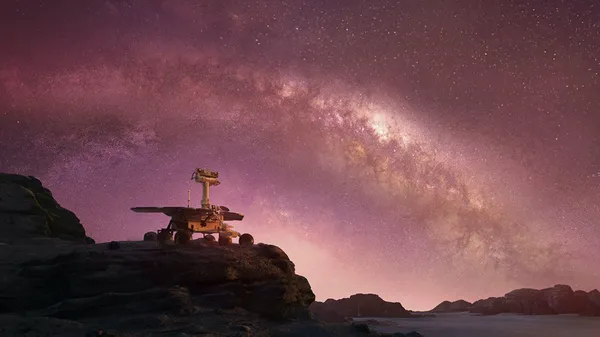 |
| Good Night Oppy |
It has just won the prize for Best Documentary at the Critics’ Choice Documentary Awards, along with four others, and it’s considered one of the front runners for next year ‘s Oscars. Good Night Oppy is the story of NASA Mars rovers Spirt and Opportunity, following them through from conception until they finally gave up the ghost, years after they were expected to. It details their discoveries on the red planet and the experiences of the crew who helped them to overcome the odds again and again. A couple of weeks ago, I met directors Ryan White and Helen Kearns, together with composer Blake Neely and co-editor Rejh Cabrera at a press conference, where Ryan spoke about the origins of the film.
“It was March 12 2020, when Jessica Hargrave, my producing partner, and I had dinner with Film 45, which is Pete Berg's company, and Amblin entertainment, which is obviously Steven Spielberg's company. And they pitched us this idea for a documentary about a robot that was supposed to live for 90 days, but survived for 15 years. And Jess and I looked at each other right away, and we're sold. We were best friends since we were little kids growing up in Atlanta, Georgia, we had always wanted to make a space film. I was a total space geek.
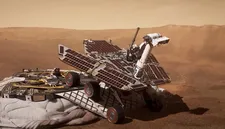 |
| Leaving the landing site |
“Growing up as a kid, my fifth grade social science project was about Alan Shepard, the astronaut, and my cabbage patch doll was the astronaut version. I wanted to be an astronaut, but became a filmmaker. And so into our adulthood, we were always looking for what was the perfect space story that suited our filmmaking style and I don't think we ever thought that would be a story about a robot. All of our films are about people – usually one person. But when we learned more about this story, and especially about the human beings that were behind this robot, and how truly emotional this story was for them, we were sold. So that was March 12. And of course, the next morning in Los Angeles is when we got the email saying you can't leave your homes anymore. And that was the genesis of this project.”
It all gelled when it was proposed that animation could be used to recreate the Martian scenes based on the rovers’ own data.
“ILM produced the film with us. So there was very early conversation, even at that dinner, where I thought, if we're going to make this film, let's take the audience to Mars in a way they've never been taken before. Like, my filmography is usually not historical or retrospective films. I'm mostly a vérité filmmaker who's out there with my camera in the field following something unfolding in somebody's life. And so if we were going to make this movie, we wanted people to feel like they were on that journey, that it wasn't looking back at a 15 year journey that had already had its beginning and middle and end. we wanted the audience to start at the beginning and be there day after day on this journey with the robots.
“The way to achieve that was to work with Industrial Light and Magic in creating, for the first time, this type of photo real Mars. Each rover had nine cameras on her, so hundreds of thousands of photographs were taken over the course of their collective 22 and a half years on Mars. And we also had the orbital imagery above Mars that two satellites take down of the terrain, but also the rovers’ journeys. And then we had all of the data from NASA. Obviously, they're incredible researchers and collectors of this data. So that was the minute details, like the temperature each day, the level of dust in the air each day, where the sun rose, where the sun set.
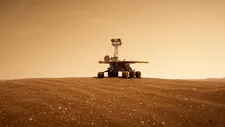 |
| Looking for adventure |
“So we went to ILM and said ‘Are you capable of using all of this photography and data and creating a photo real Mars?’ And they said ‘We've never done that before, but we're capable. We've created Mars, but that's based on an actor in a desert in Utah, we create Mars around them. We've never built it from the ground up, but we are capable of it.’ So that's when we partnered with them. And that was the beginning. You know, it takes years to create these visual effects. So for a long time, we're cutting our film with black and white pencil sketches, and just really trusting that ILM will bring it alive in the end. The biggest compliments we're getting now that the film has come out is from the people at NASA who work on Mars as their mission every day, saying like, ‘We never believed that it could look this real in a film.”
“On March 12 2020, in my studio, I got a text from Ryan,” says Blake. “He said ‘Hey, do you want to go to dinner? We have a surprise for you.’ So I go over, and I was like him, my first sixth grade project was building space shuttle model called Space Nerd, and they pitched the idea and I'm like, ‘Done.’ Then we woke up the next day, it's like, ‘Oh, we're making a movie. Now we're all stuck in our homes.’ But over the course of months, we talked about what this would need. And Like Ryan said, we've always made movies about humans, and the human story. And this was a robot.
“So you're like, ‘Well, you know, music is magic in the movies.’ And so music's role in this was going to be to humanise them. So that was the biggest goal, to humanise these robots. And then the other thing that I think was fun that music could do is supply excitement and pace. I mean, they're moving like point one mile per hour, but the score is going fast.”
I ask if they feel that the film has a mission in getting people to recover their optimism about science. TIt features several NASA employees discussing their childhood inspiration; might it, in turn, inspire the next generation of space scientists?
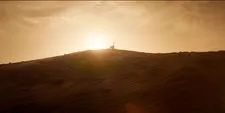 |
| A moment of discovery |
“Sure,” says Ryan. “I mean, we were very conscious from the beginning of the film that we wanted it to reach the widest audience possible. We always knew we weren't making a kid's film, but we wanted adults to be able to take their kids and watch this film. Like I said, my favourite film growing up was E.T.. It's not dumbed down for kids, but kids can relate to that type of journey. And so we were very conscious of that, especially in the people that we included in the film. I mean, our film hasn't even come out yet minus this weekend in theatres, but in the few screenings I've gone to at film festivals and in-person screenings, my favourite moments have been kids in the audience, you know, like as young as six, through teenagers, when they ask questions or they get to meet the scientists or engineers afterwards that were that in the film.
“We were at a screening in San Francisco this past week with 250 people and I didn't know until I walked in that it was all fourth graders to sixth graders, and they were cheering like crazy throughout the film. Normally as a filmmaker, that would drive you insane, because so much dialogue is being missed, because they're standing up and like, high fiving. And the whole final five minutes of the film with Perseverance launching, with some of the most important themes of our film being said there, they were all just cheering where you couldn't hear a thing. And Jess and I were standing on the side, we had tears in our eyes.
“We got to do a Q&A with them afterwards and it was the most – not to take anything away from adults’ Q&A’s, which can be wonderful - but the kids would ask questions like ‘How did it feel making that film?’ One young girl asked like, ‘Did you have fun?’ And it was just like this energy in the room that as a documentary filmmaker, so many other stories that we tell which are incredibly important, are way too heavy, that my niece and nephew could never come and watch. And this was such a rare opportunity to make something that hopefully, kids can not only enjoy and find entertaining, but also might watch and say ‘I'm a young girl in India, look at this woman who found space when she was a young girl like me – who says I can't do that?’ And I know that sounds a little cheesy, but it's one of my favourite parts of telling this story.”
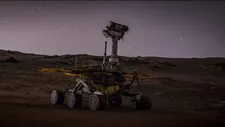 |
| Time for rovers to sleep |
Helen nods. “To echo what Ryan says, like, completely, as a young kid, I think I was curious about space and interested in it. But as a young woman, very quickly in my mind put that off. It's something that’s not really for me. It's like ‘That's a boy thing.’ You know? And I think it's so wonderful that we have so many incredible women in this film – and young women, too. Someone who's like a young Helen could go into the theatre and see this film and be like, ‘Oh, well, I could be an engineer, I could work on projects like this, I can go to space. It's something that's really important to me, and a big reason that I wanted to work on the film, to push that idea that anyone who's really interested in or curious about space exploration or being an engineer, anywhere in that kind of science field, can do that, and there's opportunity there.”
“Before entering film, I was a biology and chemistry major and minored in the science fields, basically,” says Blake. “And so it was like, reigniting these old loves that I had for science. But one of the things that was fascinating about working on the film was just seeing how there were generations of these JPL-ers, and how previous generations would inspire younger generations. It was great to see that unfold in the editing of the film, but also with the hope that other people would experience that kind of arc.”
Rejh also has a comment to make. “To me, it was very interesting that we were making this during a time that everyone was like, ‘We're going backwards as a nation. We're stuck in a pandemic...and we're not, really. When you see what these incredible people do, we're just constantly going forward. So it was this inspiration of hope. I mean, that's why space exploration is crazy. It's just the ultimate hopeful trying to move things forward. So yeah, hopefully it does make people believe more in science. We needed it two years ago. That's what I love about it.”
Good Night Oppy is in cinemas now and will be available on Amazon Prime from 23 November.





















